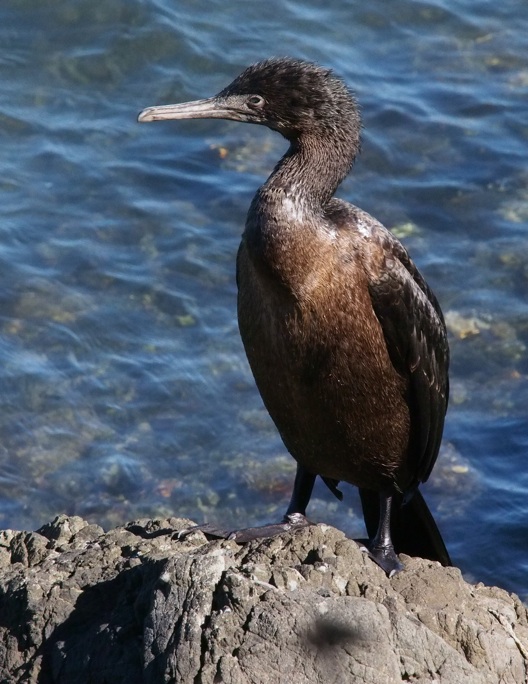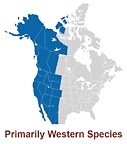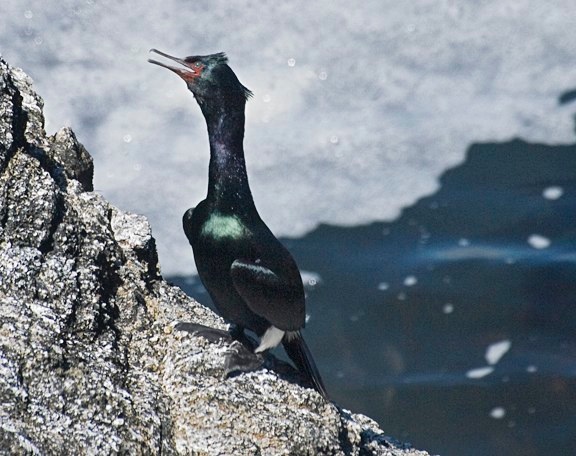A practical guide to bird watching in Sonoma County, California
(Unless otherwise indicated, all phone numbers are in the 707 area code)
A practical guide to bird watching in Sonoma County, California
(Unless otherwise indicated, all phone numbers are in the 707 area code)


Three species of cormorant are normally present in Sonoma County--Double-crested Cormorant (Phalacrocorax auritus), Brandt's Cormorant, and Pelagic Cormorant. Brandt's and Pelagic Cormorant are exclusively coastal species. Brandt’s Cormorants may be encountered well out at sea but are very rarely seen even a short distance inland. Double-crested Cormorant is common at the coast but just as likely to be found somewhat inland or perched in a tree. Locally, the three species can be found together fairly reliably at the mouth of the Russian River. Brandt’s Cormorant is present in Sonoma County all year. Easily seen off Bodega Head on rocks or flying offshore there and in other coastal areas, usually low to the water and often in linear formations. Nests on offshore rocks, often near Pelagic Cormorants, but the Brandt’s Cormorants nest in loose groups, favoring flattish or gently sloping rocks, while Pelagic Cormorants pair off and favor much steeper, craggier areas.
A large, chunky, dark cormorant with a heavy bill obviously hooked at the tip. Overall, blackish grey in non-breeding plumage but with a grey patch of skin under the chin that turns blue during the breeding season and, below that, a more conspicuous buff patch at the throat--although both the patch and the bare skin can be hard to see in the field. Young birds are browner than adults and have a somewhat pale breast and may show a less-defined chin patch.
Often confused with its close relative Pelagic Cormorant (Phalacrocorax pelagicus), which, however, is distinguished by its smaller, rounder head and very thin, pencil-like bill with a dainty hook that is obvious only at close range and when the bird has its bill open. Double-crested Cormorant is usually less confusing for a number of reasons. As noted above, it may stray inland and perch in trees (virtually eliminating the other two species), and it flies with a characteristic kink in the neck lacking in both Brandt's and Pelagic Cormorants, which fly with their necks held relatively straight. Double-crested Cormorant has a conspicuous orange-yellow patch at the throat in all plumages (although much brighter during breeding season). The yellow extends to the lores and may extend along the lower mandible. Brandt's Cormorant has a pale beige to white throat patch that acquires a blue segment in breeding plumage (photo below). Pelagic Cormorant, is the smallest and most slender of the three species and has a notably thin bill without the bulge and conspicuous hook at the tip shared by Double-crested Cormorant and Brandt's Cormorant. The entire head of Pelagic Cormorant looks small when seen beside Brandt's. Pelagic Cormorant develops white patches at the lower flanks in breeding plumage (photo below) that make it very easy to spot and distinguish during breeding season, especially in flight. Brandt’s Cormorant lacks these patches. In breeding plumage, Pelagic Cormorant will have red at the base of the bill, but, again, but can be hard to see in the field. The 2010 Peterson edition has a good comparison of the heads of the three species on page 81.
Swimming cormorants are often confused with loons at a distance because they swim similarly low in the water and typically with their heads held up, which may suggest Red-throated Loon (Gavia stellata) in particular.
Further reading:
Bolander and Parmeter, Birds of Sonoma County California, rev. ed., 2000, p. 22
Brinkley, National Wildlife Federation Field Guide to Birds of North America, 2007, pp. 84-85, 94
Burridge, ed., Sonoma County Breeding Bird Atlas, 1995, p. 27
Dunn and Alderfer, eds., National Geographic Field Guide to the Birds of North America, 5th ed., 2006, p. 106
Dunn and Alderfer, eds., National Geographic Field Guide to the Birds of North America, 6th ed., 2011, p. 108
Dunne, Pete Dunne’s Essential Field Guide Companion, 2006, pp. 119-120
Ehrlich, Dobkin, and Wheye, The Birder's Handbook, paperback edition, 1988, p. 28
Fix and Bezener, Birds of Northern California, 2000, p. 57
Floyd, Smithsonian Field Guide to the Birds of North America, 2008, p. 101
Kaufman, Field Guide to Birds of North America, 2000, p. 70
Lukas, Bay Area Birds: From Sonoma County to Monterey Bay, 2012, pp. 48-51
Parmeter and Wight, Birds of Sonoma County California, Update (2000-2010), 2012, p. 17
Peterson, Field Guide to Birds of Western North America, 4th ed., 2010, p. 80
Peterson, Western Birds, 3rd ed., 1990, p. 28
Sibley, Field Guide to Birds of Western North America,1st ed., 2003, p. 51
Stokes, Stokes Field Guide to the Birds of North America, 1st ed., 2010, p. 117
Vuilleumier, American Museum of Natural History, Birds of North America: Western Region, 2011, p. 99
Voice: Cornell Lab of Ornithology: All About Birds--Brandt’s Cormorant
© Colin Talcroft, 2009, 2010, 2011, 2012, 2013, 2014, 2015, 2016
Unless noted, all photos by the author. If you would like to use one of my images, please ask for permission for non-commercial use with proper credit or commercial use with proper compensation.

For Comparison: Pelagic Cormorant (non-breeding plumage):
Note the small, roundish head and the straight, thin,
dark bill with no obvious hook

For comparison: Double-crested Cormorant drying its wings. Spring Lake, Santa Rosa
September 23, 2012

Brandt’s Cormorant
Phalacrocorax penicillatus
Brandt’s Cormorant in flight, Santa Cruz County, May 26, 2014
1990-2015 Sonoma County data. Graph provided by eBird (www.ebird.org), generated October 27, 2015
EBird reported occurrence in Sonoma County


Brandt’s Cormorant flight silhouette

Brandt’s Cormorant, breeding plumage
Santa Cruz County, May 26, 2014

Brandt’s Cormorant (first-year bird), Campbell Cove, Bodega Bay, October 21, 2015



For Comparison: Pelagic Cormorant (breeding plumage):
Note the red at the lores and gape, and the white feathers at the lower flank,
both present only in breeding season